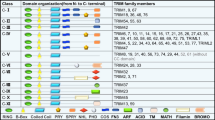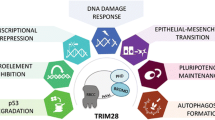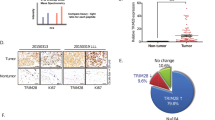Abstract
New clinical evidence suggests that dysregulation of the ubiquitin-mediated destruction of tumor suppressors or oncogene products is probably engaged in the etiology of leukemia and carcinoma. The superfamily of tripartite motif (TRIM)-containing protein family is among the biggest recognized single protein RING finger E3 ubiquitin ligases that are considered vital carcinogenesis regulators, which is not shocking since TRIM proteins are engaged in various biological processes, including cell growth, development, and differentiation; hence, TRIM proteins’ alterations may influence apoptosis, cell proliferation, and transcriptional regulation. In this review article, the various mechanisms through which TRIM proteins exert their role in the most prevalent malignancies including lung, prostate, colorectal, liver, breast, brain cancer, and leukemia are summarized.



Similar content being viewed by others
Abbreviations
- ADC:
-
Adenocarcinoma
- APL:
-
Acute promyelocytic leukemia
- BRAF:
-
B-Raf proto-oncogene serine/threonine-protein kinase
- TRIM:
-
The superfamily of tripartite motif-containing proteins
- ISG15:
-
IFN-stimulated protein of 15
- PML:
-
Promyelocytic leukemia gene
- SUMO:
-
Small ubiquitin-like modifier
- RET:
-
Rearranged during transfection
- NSCLC:
-
Non-small cell lung cancer
- SCLC:
-
Small cell lung cancer
- LCC:
-
Large cell carcinoma
- SCC:
-
Squamous cell carcinoma
- Mdm2:
-
Mouse double minute 2 homolog
- STAT3:
-
Signal transducer and activator of transcription 3
- TNBC:
-
Triple-negative breast cancer
- Nrf2:
-
Nuclear factor erythroid 2–related factor 2
- GBM:
-
Glioblastoma
References
Ozato K, Shin D-M, Chang T-H, Morse HC 3rd. TRIM family proteins and their emerging roles in innate immunity. Nat Rev Immunol. 2008;8(11):849–60.
Watanabe M, Hatakeyama S. TRIM proteins and diseases. J Biochem. 2017;161(2):135–44.
Cappadocia L, Lima CD. Ubiquitin-like protein conjugation: structures, chemistry, and mechanism. Chem Rev. 2018;118(3):889–918.
Liu J, Zhang C, Wang X, Hu W, Feng Z. Tumor suppressor p53 cross-talks with TRIM family proteins. Genes Dis. 2021;8(4):463–74.
Giraldo MI, Hage A, van Tol S, Rajsbaum R. TRIM proteins in host defense and viral pathogenesis. Cur Clin Microbiol Rep. 2020;7(4):1–14.
Mandell MA, Saha B, Thompson TA. The tripartite nexus: autophagy, cancer, and tripartite motif-containing protein family members. Front Pharmacol. 2020;11:308.
Hao L, Du B, Xi X. TRIM59 is a novel potential prognostic biomarker in patients with non-small cell lung cancer: a research based on bioinformatics analysis. Oncol Lett. 2017;14(2):2153–64.
Aierken G, Seyiti A, Alifu M, Kuerban G. Knockdown of tripartite-59 (TRIM59) inhibits cellular proliferation and migration in human cervical cancer cells. Oncol Res. 2017;25(3):381–8.
Guan D, Kao H-Y. The function, regulation and therapeutic implications of the tumor suppressor protein, PML. Cell Biosci. 2015;5(1):60.
Valletti A, Marzano F, Pesole G, Sbisà E, Tullo A. Targeting chemoresistant tumors: could TRIM proteins-p53 axis be a possible answer? Int J Mol Sci. 2019;20(7):1776.
Hatakeyama S. TRIM proteins and cancer. Nat Rev Cancer. 2011;11(11):792–804.
Hatakeyama S. TRIM family proteins: roles in autophagy, immunity, and carcinogenesis. Trends Biochem Sci. 2017;42(4):297–311.
Di Rienzo M, Romagnoli A, Antonioli M, Piacentini M, Fimia GM. TRIM proteins in autophagy: selective sensors in cell damage and innate immune responses. Cell Death Differ. 2020;27(3):887–902.
Shriwash N, Singh P, Arora S, Ali SM, Ali S, Dohare R. Identification of differentially expressed genes in small and non-small cell lung cancer based on meta-analysis of mRNA. Heliyon. 2019;5(6):e01707.
Wang X, Shi W, Shi H, Lu S, Wang K, Sun C, et al. TRIM11 overexpression promotes proliferation, migration and invasion of lung cancer cells. J Exp Clin Cancer Res. 2016;35(1):100.
Huang J, Tang L, Zhao Y, Ding W. TRIM11 promotes tumor angiogenesis via activation of STAT3/VEGFA signaling in lung adenocarcinoma. Am J Cancer Res. 2019;9(9):2019–27.
Han Y, Tian H, Chen P, Lin Q. TRIM47 overexpression is a poor prognostic factor and contributes to carcinogenesis in non-small cell lung carcinoma. Oncotarget. 2017;8(14):22730.
Xing Y, Meng Q, Chen X, Zhao Y, Liu W, Hu J, et al. TRIM44 promotes proliferation and metastasis in non-small cell lung cancer via mTOR signaling pathway. Oncotarget. 2016;7(21):30479.
Lin Z, Lin X, Zhu L, Huang J, Huang Y. TRIM2 directly deubiquitinates and stabilizes Snail1 protein, mediating proliferation and metastasis of lung adenocarcinoma. Cancer Cell Int. 2020;20(1):228.
Hai J, Zhu C-Q, Wang T, Organ SL, Shepherd FA, Tsao M-S. TRIM14 is a putative tumor suppressor and regulator of innate immune response in non-small cell lung cancer. Sci Rep. 2017;7(1):39692.
Lu K, Sui Y, Fu L. Identification of TRIM56 as a potential biomarker for lung adenocarcinoma. Cancer Manag Res. 2021;13:2201.
Rawla P. Epidemiology of prostate cancer. World J Oncol. 2019;10(2):63.
Mangangcha IR, Malik MZ, Küçük Ö, Ali S, Singh RKB. Identification of key regulators in prostate cancer from gene expression datasets of patients. Sci Rep. 2019;9(1):16420.
Khatamianfar V, Valiyeva F, Rennie PS, Lu W-y, Yang BB, Bauman GS, et al. TRIM59, a novel multiple cancer biomarker for immunohistochemical detection of tumorigenesis. BMJ Open. 2012;2(5):e001410.
Kimura N, Yamada Y, Takayama Ki, Fujimura T, Takahashi S, Kume H, et al. Androgen-responsive tripartite motif 36 enhances tumor-suppressive effect by regulating apoptosis-related pathway in prostate cancer. Cancer Sci. 2018;109(12):3840–52.
Liang C, Wang S, Qin C, Bao M, Cheng G, Liu B, et al. TRIM36, a novel androgen-responsive gene, enhances anti-androgen efficacy against prostate cancer by inhibiting MAPK/ERK signaling pathways. Cell Death Dis. 2018;9(2):1–13.
Fujimura T, Inoue S, Urano T, Takayama K, Yamada Y, Ikeda K, et al. Increased expression of tripartite motif (TRIM) 47 is a negative prognostic predictor in human prostate cancer. Clin Genitourin Cancer. 2016;14(4):298–303.
Kanno Y, Watanabe M, Kimura T, Nonomura K, Tanaka S, Hatakeyama S. TRIM29 as a novel prostate basal cell marker for diagnosis of prostate cancer. Acta Histochem. 2014;116(5):708–12.
Groner AC, Cato L, de Tribolet-Hardy J, Bernasocchi T, Janouskova H, Melchers D, et al. TRIM24 is an oncogenic transcriptional activator in prostate cancer. Cancer Cell. 2016;29(6):846–58.
Bray F, Ferlay J, Soerjomataram I, Siegel RL, Torre LA, Jemal A. Global cancer statistics 2018: GLOBOCAN estimates of incidence and mortality worldwide for 36 cancers in 185 countries. CA: A Cancer J Clin. 2018;68(6):394–424.
Dekker E, Tanis PJ, Vleugels JLA, Kasi PM, Wallace MB. Colorectal cancer. Lancet. 2019;394(10207):1467–80.
Yazdani Z, Rafiei A, Golpour M, Zafari P, Moonesi M, Ghaffari S. IL-35, a double-edged sword in cancer. J Cell Biochem. 2020;121(3):2064–76. https://doi.org/10.1002/jcb.29441.
Han Y, Tan Y, Zhao Y, Zhang Y, He X, Yu L, et al. TRIM23 overexpression is a poor prognostic factor and contributes to carcinogenesis in colorectal cancer. J Cell Mol Med. 2020;24(10):5491–500.
Nasrullah U, Haeussler K, Biyanee A, Wittig I, Pfeilschifter J, Eberhardt W. Identification of TRIM25 as a negative regulator of caspase-2 expression reveals a novel target for sensitizing colon carcinoma cells to intrinsic apoptosis. Cells. 2019;8(12):1622.
Fitzgerald S, Espina V, Liotta L, Sheehan KM, O’Grady A, Cummins R, et al. Stromal TRIM28-associated signaling pathway modulation within the colorectal cancer microenvironment. J Transl Med. 2018;16(1):1–11.
Mastropasqua F, Marzano F, Valletti A, Aiello I, Di Tullio G, Morgano A, et al. TRIM8 restores p53 tumour suppressor function by blunting N-MYC activity in chemo-resistant tumours. Mol Cancer. 2017;16(1):1–16.
Cao H, Fang Y, Liang Q, Wang J, Luo B, Zeng G, et al. TRIM2 is a novel promoter of human colorectal cancer. Scand J Gastroenterol. 2019;54(2):210–8.
Lee HJ. The role of tripartite motif family proteins in TGF-β signaling pathway and cancer. J Cancer Prev. 2018;23(4):162–9.
Liang Q, Tang C, Tang M, Zhang Q, Gao Y, Ge Z. TRIM47 is up-regulated in colorectal cancer, promoting ubiquitination and degradation of SMAD4. J Exp Clin Cancer Res. 2019;38(1):159.
Zheng S, Zhou C, Wang Y, Li H, Sun Y, Shen Z. TRIM6 promotes colorectal cancer cells proliferation and response to thiostrepton by TIS21/FoxM1. J Exp Clin Cancer Res. 2020;39(1):23.
He T, Cui J, Wu Y, Sun X, Chen N. Knockdown of TRIM66 inhibits cell proliferation, migration and invasion in colorectal cancer through JAK2/STAT3 pathway. Life Sci. 2019;235:116799.
Wang F, Ruan L, Yang J, Zhao Q, Wei W. TRIM14 promotes the migration and invasion of gastric cancer by regulating epithelial-to-mesenchymal transition via activation of AKT signaling regulated by miR-195-5p. Oncol Rep. 2018;40(6):3273–84.
Jin Z, Li H, Hong X, Ying G, Lu X, Zhuang L, et al. TRIM14 promotes colorectal cancer cell migration and invasion through the SPHK1/STAT3 pathway. Cancer Cell Int. 2018;18:202.
Chen M, Zhao Z, Meng Q, Liang P, Su Z, Wu Y, et al. TRIM14 promotes noncanonical NF-κB activation by modulating p100/p52 stability via selective autophagy. Adv Sci (Weinheim, Baden-Wurttemberg, Germany). 2019;7(1):1901261.
Xie Y, Zhao Y, Shi L, Li W, Chen K, Li M, et al. Gut epithelial TSC1/mTOR controls RIPK3-dependent necroptosis in intestinal inflammation and cancer. J Clin Invest. 2020;130(4):2111–28.
Wang H, Yao L, Gong Y, Zhang B. TRIM31 regulates chronic inflammation via NF-κB signal pathway to promote invasion and metastasis in colorectal cancer. Am J Transl Res. 2018;10(4):1247–59.
Noguchi K, Okumura F, Takahashi N, Kataoka A, Kamiyama T, Todo S, et al. TRIM40 promotes neddylation of IKKγ and is downregulated in gastrointestinal cancers. Carcinogenesis. 2011;32(7):995–1004.
Papadatos-Pastos D, Rabbie R, Ross P, Sarker D. The role of the PI3K pathway in colorectal cancer. Crit Rev Oncol Hematol. 2015;94(1):18–30.
Xing L, Tang X, Wu K, Huang X, Yi Y, Huan J. TRIM27 functions as a novel oncogene in non-triple-negative breast cancer by blocking cellular senescence through p21 ubiquitination. Mol Ther - Nucleic Acids. 2020;22:910–23.
Llovet JM, Kelley RK, Villanueva A, Singal AG, Pikarsky E, Roayaie S, et al. Hepatocellular carcinoma. Nat Rev Dis Primers. 2021;7(1):6.
Liu Y, Tao S, Liao L, Li Y, Li H, Li Z, et al. TRIM25 promotes the cell survival and growth of hepatocellular carcinoma through targeting Keap1-Nrf2 pathway. Nat Commun. 2020;11(1):348.
Lee H-L, Chien Y-C, Chiang W-L, Wang H-L, Hsueh K-C, Chen C-H, et al. Analysis of TRIM21 genetic variants on the clinicopathologic characteristics of patients with hepatocellular carcinoma. Processes. 2021;9(3):495.
Wang Y, He D, Yang L, Wen B, Dai J, Zhang Q, et al. TRIM26 functions as a novel tumor suppressor of hepatocellular carcinoma and its downregulation contributes to worse prognosis. Biochem Biophys Res Commun. 2015;463(3):458–65.
Liu J, Rao J, Lou X, Zhai J, Ni Z, Wang X. Upregulated TRIM11 exerts its oncogenic effects in hepatocellular carcinoma through inhibition of P53. Cell Physiol Biochem. 2017;44(1):255–66.
Dong B, Zhang W. High levels of TRIM14 are associated with poor prognosis in hepatocellular carcinoma. Oncol Res Treat. 2018;41(3):129–34.
Xu M, Hu J, Zhou B, Zhong Y, Lin N, Xu R. TRIM29 prevents hepatocellular carcinoma progression by inhibiting Wnt/β-catenin signaling pathway. Acta Biochim Biophys Sin. 2019;51(1):68–77.
Ghoncheh M, Pournamdar Z, Salehiniya H. Incidence and mortality and epidemiology of breast cancer in the world. Asian Pac J Cancer Prev. 2016;17(sup3):43–6.
Iranshahi N, Zafari P, Yari KH, Alizadeh E. The most common genes involved in epigenetics modifications among Iranian patients with breast cancer: a systematic review. Cell Mol Biol (Noisy-le-grand). 2016;62(12):116–22. https://doi.org/10.14715/cmb/2016.62.12.20.
Győrffy B, Hatzis C, Sanft T, Hofstatter E, Aktas B, Pusztai L. Multigene prognostic tests in breast cancer: past, present, future. Breast Cancer Res. 2015;17(1):1–7.
Kawabata H, Azuma K, Ikeda K, Sugitani I, Kinowaki K, Fujii T, et al. TRIM44 is a poor prognostic factor for breast cancer patients as a modulator of NF-κB signaling. Int J Mol Sci. 2017;18(9):1931.
Zhou W, Zhang Y, Zhong C, Hu J, Hu H, Zhou D, et al. Decreased expression of TRIM21 indicates unfavorable outcome and promotes cell growth in breast cancer. Cancer Manag Res. 2018;10:3687.
Tan P, Ye Y, He L, Xie J, Jing J, Ma G, et al. TRIM59 promotes breast cancer motility by suppressing p62-selective autophagic degradation of PDCD10. PLoS Biol. 2018;16(11):e3000051.
Xu Y, Zhang Z, Xu G. TRIM proteins in neuroblastoma. Biosci Rep. 2019;39(12):BSR20192050.
Zoumpoulidou G, Broceño C, Li H, Bird D, Thomas G, Mittnacht S. Role of the tripartite motif protein 27 in cancer development. J Natl Cancer Inst. 2012;104(12):941–52. https://doi.org/10.1093/jnci/djs224.
Feng S, Cai X, Li Y, Jian X, Zhang L, Li B. Tripartite motif-containing 14 (TRIM14) promotes epithelial-mesenchymal transition via ZEB2 in glioblastoma cells. J Exp Clin Cancer Res. 2019;38(1):1–13.
Nestler U, Lutz K, Pichlmeier U, Stummer W, Franz K, Reulen H, et al. Anatomic features of glioblastoma and their potential impact on survival. Acta Neurochir. 2015;157(2):179–86.
Ji J, Ding K, Luo T, Zhang X, Chen A, Zhang D, et al. TRIM22 activates NF-κB signaling in glioblastoma by accelerating the degradation of IκBα. Cell Death Differ. 2021;28(1):367–81.
Chen G, Kong J, Tucker-Burden C, Anand M, Rong Y, Rahman F, et al. Human Brat ortholog TRIM3 is a tumor suppressor that regulates asymmetric cell division in glioblastoma. Can Res. 2014;74(16):4536–48.
Wei H, Ding C, Zhuang H, Hu W. TRIM47 promotes the development of glioma by ubiquitination and degradation of FOXO1. Onco Targets Ther. 2020;13:13401.
Zhang C, Mukherjee S, Tucker-Burden C, Ross JL, Chau MJ, Kong J, et al. TRIM 8 regulates stemness in glioblastoma through PIAS 3-STAT 3. Mol Oncol. 2017;11(3):280–94.
Qi ZX, Cai JJ, Chen LC, Yue Q, Gong Y, Yao Y, et al. TRIM28 as an independent prognostic marker plays critical roles in glioma progression. J Neurooncol. 2016;126(1):19–26.
Tang S-L, Gao Y-L, Wen-Zhong H. Knockdown of TRIM37 suppresses the proliferation, migration and invasion of glioma cells through the inactivation of PI3K/Akt signaling pathway. Biomed Pharmacother. 2018;99:59–64.
Vardiman JW, Thiele J, Arber DA, Brunning RD, Borowitz MJ, Porwit A, et al. The 2008 revision of the World Health Organization (WHO) classification of myeloid neoplasms and acute leukemia: rationale and important changes. Blood. 2009;114(5):937–51.
Quintás-Cardama A, Zhang N, Qiu YH, Post S, Creighton CJ, Cortes J, et al. Loss of TRIM62 expression is an independent adverse prognostic factor in acute myeloid leukemia. Clin Lymphoma Myeloma Leukemia. 2015;15(2):115–27.
Nathan B, Knut N, David T, Caroline B, Noelle P-L, Anthoney LC, et al. The Zebrafish moonshine gene encodes transcriptional intermediary factor 1gamma, an essential regulator of hematopoiesis. PLoS Biol. 2004. https://doi.org/10.1371/journal.pbio.0020237.
Aucagne R, Droin N, Paggetti J, Lagrange B, Largeot A, Hammann A, et al. Transcription intermediary factor 1γ is a tumor suppressor in mouse and human chronic myelomonocytic leukemia. J Clin Investig. 2011;121(6):2361–70.
Li F, Hu L, Xu Y, Li Z, Yi S, Gu Z, et al. Identification of characteristic and prognostic values of chromosome 1p abnormality by multi-gene fluorescence in situ hybridization in multiple myeloma. Leukemia. 2016;30(5):1197–201.
Herquel B, Ouararhni K, Davidson I. The TIF1α-related TRIM cofactors couple chromatin modifications to transcriptional regulation, signaling and tumor suppression. Transcription. 2011;2(5):231–6.
Gandini D, De Angeli C, Aguiari G, Manzati E, Lanza F, Pandolfi P, et al. Preferential expression of the transcription coactivator HTIF1 α gene in acute myeloid leukemia and MDS-related AML. Leukemia. 2002;16(5):886–93.
Kapanadze B, Makeeva N, Corcoran M, Jareborg N, Hammarsund M, Baranova A, et al. Comparative sequence analysis of a region on human chromosome 13q14, frequently deleted in B-cell chronic lymphocytic leukemia, and its homologous region on mouse chromosome 14. Genomics. 2000;70(3):327–34.
Baranova A, Hammarsund M, Ivanov D, Skoblov M, Sangfelt O, Corcoran M, et al. Distinct organization of the candidate tumor suppressor gene RFP2 in human and mouse: multiple mRNA isoforms in both species-and human-specific antisense transcript RFP2OS. Gene. 2003;321:103–12.
Kupperman E, Lee EC, Cao Y, Bannerman B, Fitzgerald M, Berger A, et al. Evaluation of the proteasome inhibitor MLN9708 in preclinical models of human cancer. Can Res. 2010;70(5):1970–80.
Zhang P-P, Ding D-Z, Shi B, Zhang S-Q, Gu L-L, Wang Y-C, et al. Expression of TRIM28 correlates with proliferation and Bortezomib-induced apoptosis in B-cell non-Hodgkin lymphoma. Leuk Lymphoma. 2018;59(11):2639–49.
Moustakim M, Clark PG, Hay DA, Dixon DJ, Brennan PE. Chemical probes and inhibitors of bromodomains outside the BET family. MedChemComm. 2016;7(12):2246–64.
Bennett J, Fedorov O, Tallant C, Monteiro O, Meier J, Gamble V, et al. Discovery of a Chemical Tool Inhibitor Targeting the Bromodomains of TRIM24 and BRPF. J Med Chem. 2016;59(4):1642–7.
Li YJ, Zhang GP, Zhao F, Li RQ, Liu SJ, Zhao ZR, et al. Target therapy of TRIM-14 inhibits osteosarcoma aggressiveness through the nuclear factor-κB signaling pathway. Exp Ther Med. 2018;15(3):2365–73.
Yu GH, Li AM, Li X, Yang Z, Peng H. Bispecific antibody suppresses osteosarcoma aggressiveness through regulation of NF-κB signaling pathway. Tumour Biol. 2017;39(6):1010428317705572.
Zhan W, Zhang S. TRIM proteins in lung cancer: mechanisms, biomarkers and therapeutic targets. Life Sci. 2021. https://doi.org/10.1016/j.lfs.2020.118985.
Chen Z, Chen S-J. RARA and PML genes in acute promyelocytic leukemia. Leuk Lymphoma. 1992;8(4–5):253–60.
Ito K, Bernardi R, Morotti A, Matsuoka S, Saglio G, Ikeda Y, et al. PML targeting eradicates quiescent leukaemia-initiating cells. Nature. 2008;453(7198):1072–8.
Belloni E, Trubia M, Gasparini P, Micucci C, Tapinassi C, Confalonieri S, et al. 8p11 myeloproliferative syndrome with a novel t (7; 8) translocation leading to fusion of the FGFR1 and TIF1 genes. Genes Chromosom Cancer. 2005;42(3):320–5.
Kurahashi S, Hayakawa F, Miyata Y, Yasuda T, Minami Y, Tsuzuki S, et al. PAX5–PML acts as a dual dominant-negative form of both PAX5 and PML. Oncogene. 2011;30(15):1822–30.
Funding
The authors received no financial support for the research, authorship, and/or publication of this article.
Author information
Authors and Affiliations
Contributions
AM and FE contributed to the idea design and literature search. SeK wrote parts of the manuscript. AM contributed to designing the figures. ZM contributed in language editing and writing of manuscript. MP and SaK performed the revision.
Corresponding author
Ethics declarations
Conflict of interest
The author(s) declare that they have no conflict of interests.
Ethical approval
It is not applicable.
Informed consent
It is not applicable.
Additional information
Publisher's Note
Springer Nature remains neutral with regard to jurisdictional claims in published maps and institutional affiliations.
Rights and permissions
About this article
Cite this article
Mohammadi, A., Pour Abbasi, M.S., Khorrami, S. et al. The TRIM proteins in cancer: from expression to emerging regulatory mechanisms. Clin Transl Oncol 24, 460–470 (2022). https://doi.org/10.1007/s12094-021-02715-5
Received:
Accepted:
Published:
Issue Date:
DOI: https://doi.org/10.1007/s12094-021-02715-5




